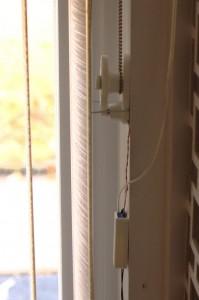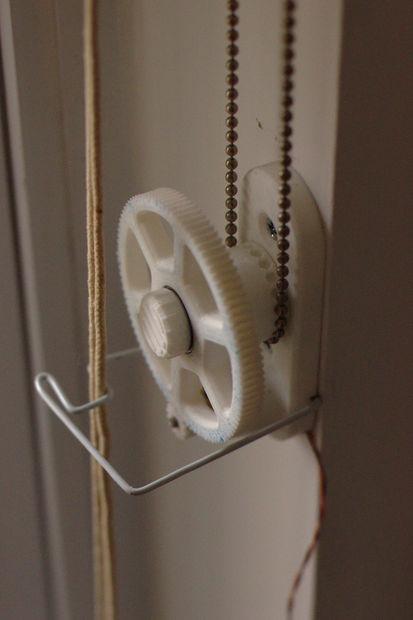If necessity is indeed the mother of invention, surely sloth — or, perhaps, forgetfulness — is the runner-up. Designer and maker, Drew Morgan (his Instructables handle is “DrewTM”), shared his design along with instructions for what he calls “Blinds’ Eye.” Blinds’ Eye is Morgan’s machine,  partially comprised of 3D-printed components, that opens and closes blinds automatically.
partially comprised of 3D-printed components, that opens and closes blinds automatically.
If it’s light outside, Blinds’ Eye’s light sensor board takes note and up go the blinds. Likewise, the sensors know when the sun has set and closes up shop as it were. Morgan says he designed Blinds’ Eye “for two reasons: security and convenience.” Along with using Blinds’ Eye to oversee his house’s window coverings, Morgan also uses timers on the lights, to fool potential burglers into believing somebody’s home.
Morgan got the majority of the parts for his prototype of Blinds’ Eye through Amazon. He estimated that parts, excluding the 3D printer required to produce many of the parts, cost about $60. You’ll need the following (see Morgan’s Instructables page for the links):
– 1 Arduino Pro Mini 5V
– 1 Sunkee light sensor board
– 1 Zitrades motor driver board
– 1 tiny motor
– 2 607 bearings
– 1 SPST switch
– 1 power supply
– 1 DC power jack
– 1 m7 x 35mm-long hex-head bolt
– wire
– You’ll need 3 screws: 2 flat-head wood or sheet metal screws, 3mm to 4mm in diameter and 15mm to 20mm long; 1 pan-head wood or sheet metal screw of the same diamter but 20mm to 25 mm long.
Morgan recommends shopping around for lower prices if you would prefer not to source largely from Amazon.
The 3D printer Morgan used was a RepRap with a 0.35mm nozzle but you can use another 3D printer as long as it has the capacity to produce small features at you will be printing, for instance, gears with small teeth. He noted that his printer was just sufficient to print the fairly intricate gears, so if you intend to construct your own Blinds’ Eye, keep that in mind. Alternatively, if you don’t own a 3D printer, you can order the parts that need to be printed for your Blinds’ Eye from Shapeways or another online 3D printing source. Morgan made the STLs and the Arduino sketch available on GitHub.
Morgan’s instructions are clear and the machine seems fairly easy to construct. He didn’t provide a ballpark figure in terms of the hours clocked to produce Blinds’ Eye but we wonder if it might not have been quicker just to walk over and draw the blinds himself!
Let us know what you think about this design in the Blinds’ Eye forum thread at 3DPB.com.
Subscribe to Our Email Newsletter
Stay up-to-date on all the latest news from the 3D printing industry and receive information and offers from third party vendors.
You May Also Like
IperionX Inks 10-Year Deal with Wisconsin Manufacturer for 80 Metric Tons of Titanium Per Year
IperionX, the Charlotte-based supplier of sustainable titanium powders used for additive manufacturing (AM) and metal injection molding (MIM), has signed a ten-year deal with United Stars, a group of industrial...
Gastronology Launches Industrial Production of 3D Printed Food for Dysphagia Patients
Food 3D printing has, in many ways, been an additive manufacturing (AM) segment looking for the right business case. While some applications are beautiful and others may or may not...
Lockheed Martin Leads $3M Investment in Q5D’s Electronics 3D Printing System
Q5D, an original equipment manufacturer (OEM) of robotic arm, hybrid additive manufacturing (AM) systems used for wire harness production, has closed a $3 million investment round. The investment arm of...
3D Printing News Briefs, April 6, 2024: Depowdering, Cybertruck Door Handles, & More
In today’s 3D Printing News Briefs, ioTech’s digital manufacturing CLAD technology is opening up opportunities for microelectronics and additive manufacturing. Hexagon and Raytheon Technologies commercially released the Simufact Additive Process...
































